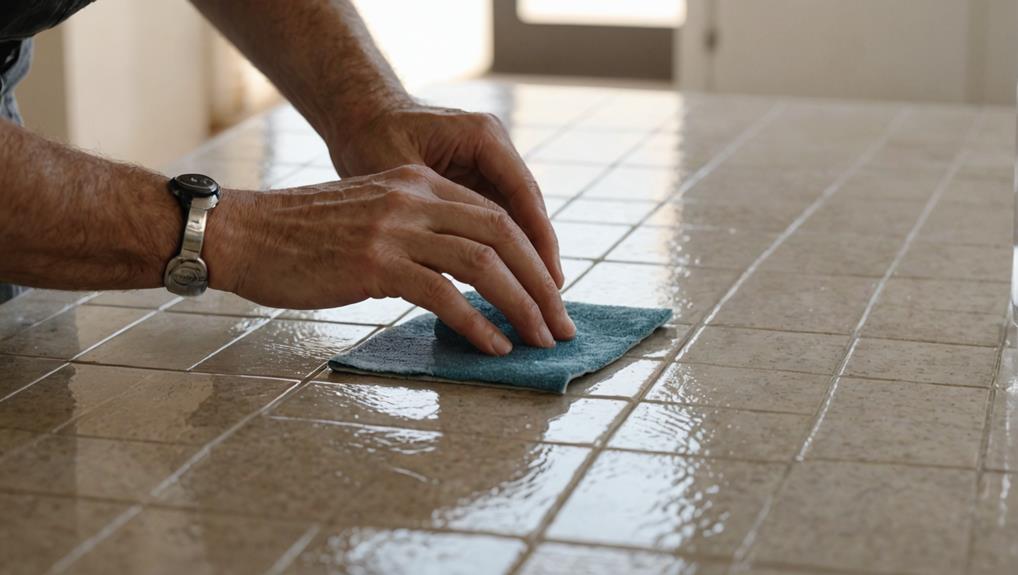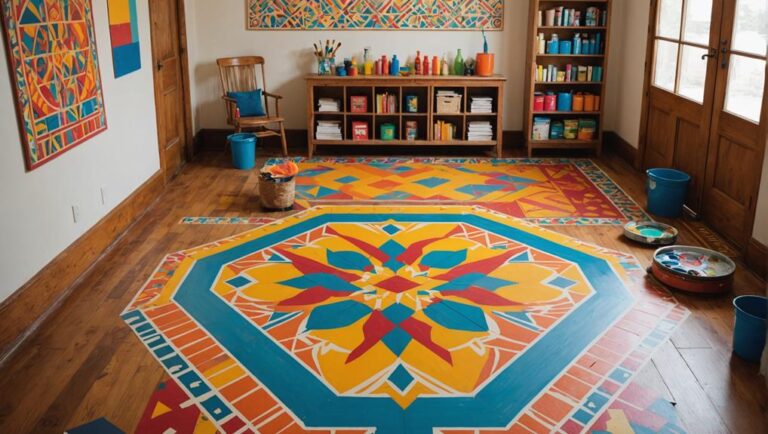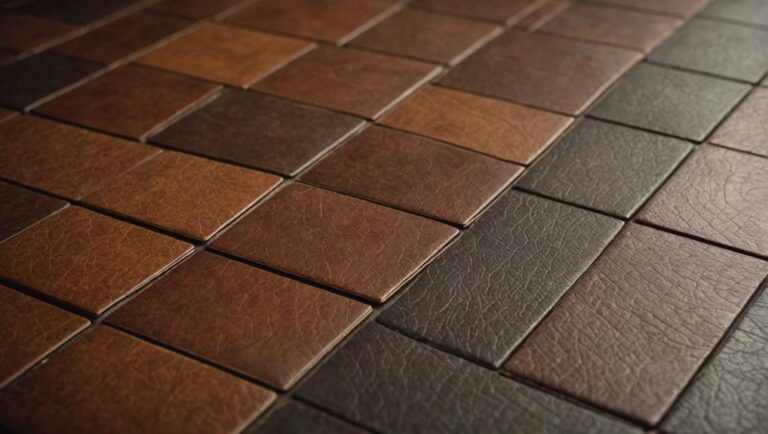To restore gloss in dull ceramic tiles, start by evaluating their condition for any damage. Clean the surface with a pH-neutral solution, using a soft mop or cloth to prevent scratches. For deeper cleaning, consider steam cleaning or a vinegar-water solution to dissolve mineral deposits. Applying a baking soda paste can help lift dirt gently. After cleaning, use a high-quality polishing compound, applying it with a soft cloth in small sections for added shine. Regular maintenance, including sealing every few years, will help maintain that gloss. You'll discover effective techniques to achieve and sustain your tile's shine.
Assessing Tile Condition
Before you can restore the gloss in dull ceramic tiles, it is vital to assess their condition thoroughly. Start with a detailed tile surface evaluation to identify any underlying damage such as cracks, chips, or stains that may have contributed to the loss of gloss. Carefully examine each tile, looking for discoloration or dull patches that could indicate wear or chemical damage.
Next, perform a gloss assessment by using a gloss meter, ideally if you have access to one. This tool measures the reflective properties of the tile surface, helping you quantify the level of gloss present. If you don't have a gloss meter, you can also assess gloss visually under various lighting conditions. A well-lit area can help you see inconsistencies in the tile's sheen.
During your evaluation, take note of any cleaning products previously used, as some may leave residues that dull the surface. It's important to document your findings, as this information will guide your restoration process. Be aware of any safety concerns, particularly if tiles are greatly damaged; sharp edges could pose a risk during cleaning or restoration efforts.
Lastly, make sure that you're equipped to handle any necessary repairs before beginning the gloss restoration process. Understanding your tiles' condition will help you select the right cleaning and polishing methods, ultimately leading to a successful restoration without compromising safety.
Basic Cleaning Techniques
To effectively restore the gloss in your dull ceramic tiles, you'll need to gather essential cleaning supplies first. Once you have everything ready, follow a step-by-step process to guarantee thorough cleaning. This approach will help you achieve ideal results and revive the shine of your tiles.
Essential Cleaning Supplies
What essential cleaning supplies do you need to effectively restore the gloss in dull ceramic tiles? First, you'll want high-quality cleaning solutions specifically designed for tile restoration. Look for pH-neutral products that won't damage the glaze or finish of your tiles. Avoid harsh acids or abrasive cleaners, as they can cause scratches or dullness.
Next, gather soft microfiber cloths or mop heads. These materials are gentle enough to clean without scratching the surface while effectively lifting dirt and grime. You'll also need a bucket for mixing your cleaning solutions, and a soft-bristle brush can be invaluable for tackling stubborn stains or grout lines without damaging the tiles.
Additionally, consider using a steam cleaner. This tool can help sanitize and rejuvenate your tiles without the need for harsh chemicals. Finally, it's wise to have gloves on hand to protect your skin from any cleaning agents you may use.
Step-by-Step Process
Start by sweeping or vacuuming the ceramic tiles to remove loose dirt and debris. This initial step is essential for effective tile restoration, as any leftover particles can scratch the surface during cleaning. Next, prepare a solution of warm water and a mild pH-neutral cleaner. Avoid harsh chemicals, as they can damage the tile surface and reduce gloss enhancement.
Using a soft mop or cloth, apply the cleaning solution to the tiles. Work in small sections to guarantee thorough coverage, and avoid soaking the tiles, which can lead to water damage. After cleaning, rinse the mop or cloth frequently in clean water to prevent dirt from being spread back onto the tiles.
Once the cleaning is complete, use a dry microfiber cloth to wipe down the tiles, promoting a streak-free finish. For additional gloss enhancement, consider applying a tile polish specifically designed for ceramic surfaces. Follow the manufacturer's instructions carefully for the best results.
Deep Cleaning Methods
While regular cleaning can help maintain the appearance of your ceramic tiles, deep cleaning methods are essential for restoring their gloss and removing embedded dirt and grime. Two highly effective deep cleaning techniques are steam cleaning and using a vinegar solution.
Steam cleaning is a powerful method that utilizes high-temperature steam to penetrate the porous surface of the tiles. This process not only disinfects but also loosens stubborn dirt and stains without the need for harsh chemicals. To safely steam clean your tiles, guarantee you use a steam cleaner designed for hard floors. Keep the nozzle a few inches away from the surface to prevent moisture from seeping into grout lines, which could lead to damage over time.
Alternatively, a vinegar solution can work wonders for restoring gloss. Mix equal parts of white vinegar and water in a spray bottle. Apply this solution directly to the tiles, allowing it to sit for about five minutes. The acidity of the vinegar helps dissolve mineral deposits and grime. Afterward, scrub the surface gently with a soft-bristle brush or mop, then rinse thoroughly with warm water to avoid any residue that could dull the finish.
Both methods can effectively rejuvenate your ceramic tiles when applied correctly. Always test a small, inconspicuous area first to guarantee compatibility with your specific tile type. Following these deep cleaning methods will help restore your tiles' shine while keeping your space safe and inviting.
Using Baking Soda
Baking soda can effectively restore the gloss in your dull ceramic tiles when used correctly. By creating a baking soda paste and applying it with specific techniques, you can enhance the tile's shine without damaging the surface. This method is not only simple but also cost-effective for maintaining your tiles' appearance.
Baking Soda Paste
To effectively restore the gloss in dull ceramic tiles, a baking soda paste can be an excellent solution. Baking soda, known for its numerous benefits, acts as a gentle abrasive that can effectively lift dirt and grime without scratching your tiles. Additionally, it's a safe option compared to harsher chemical cleaners, making it ideal for household use.
Here's what you'll need to create your baking soda paste:
- Baking Soda: Start with about half a cup.
- Water: Add enough to create a thick paste, approximately a few tablespoons.
- Mixing Bowl: Use a non-reactive bowl for mixing.
Once you've combined these ingredients, you'll have a versatile cleaning paste that can tackle stains and restore shine. While baking soda is highly effective, you might consider baking soda alternatives like vinegar or commercial tile cleaners if you prefer different cleaning methods. However, for a safe and natural approach, baking soda remains a top choice. Always verify to test any cleaning solution on a small area first to avoid potential damage.
Application Techniques
When applying the baking soda paste to restore gloss in dull ceramic tiles, it is vital to use the right technique for maximum effectiveness. Begin by confirming your tiles are clean and free from dust or debris. Use a damp cloth to wipe the surface before starting the application. Next, take your prepared baking soda paste and apply it evenly onto the tile using a soft cloth or sponge. It's important to work in small sections to prevent the paste from drying out.
For ideal gloss enhancement, gently rub the paste in circular motions, allowing it to penetrate the tile's surface. Be cautious not to apply too much pressure, as this may scratch the tile. After about five to ten minutes, rinse the area thoroughly with warm water to remove all residue.
Following this, dry the tiles with a clean towel to prevent water spots. Regularly repeating this tile rejuvenation process will help maintain the gloss and overall appearance of your ceramic tiles. Remember, safety is key, so wear gloves if you have sensitive skin and provide good ventilation in your working area.
Applying Commercial Cleaners
Commercial cleaners can be a powerful ally in restoring the shine of dull ceramic tiles. They're formulated to tackle tough stains and grime, effectively enhancing the appearance of your tiles. However, it's vital to choose the right cleaner to guarantee safety and maintain the integrity of your tiles. Here are three key steps to take into account when applying commercial cleaners:
- Select the Right Cleaner: Opt for a commercial cleaner that's suitable for ceramic tiles. Look for eco-friendly options that minimize harmful chemicals, guaranteeing a safer environment for you and your family.
- Prepare the Area: Before you start, remove any loose debris or dirt from the tiles. Sweep or vacuum the floor thoroughly. This step is important for effective tile maintenance, as it prevents scratching during the cleaning process.
- Follow Instructions Carefully: When applying the cleaner, follow the manufacturer's instructions. Typically, you'll apply the cleaner using a mop or cloth, guaranteeing even coverage without over-saturating the tiles. Allow the cleaner to sit for the recommended time to break down dirt and grime.
After cleaning, rinse the tiles with water to remove any residue and restore their luster. Regular use of commercial cleaners, especially eco-friendly options, can greatly enhance the longevity and appearance of your ceramic tiles. Always prioritize safety by wearing gloves and guaranteeing proper ventilation while working with these products.
Polishing for Extra Shine
After thoroughly cleaning your ceramic tiles with a suitable commercial cleaner, you might find that they still lack the desired shine. To achieve that extra gloss, you can utilize various polishing techniques designed specifically for ceramic surfaces. First, choose a high-quality polishing compound suitable for ceramic materials. It's vital to confirm the product is safe and compatible with your tiles to avoid any damage.
Begin by applying a small amount of the polishing compound onto a soft, clean cloth or a microfiber pad. Work in small sections, applying gentle pressure while moving in a circular motion. This technique not only helps distribute the compound evenly but also allows for better shine enhancement. Be cautious not to apply excessive pressure, which could lead to scratches or damage to the tile's surface.
After you've polished a section, wipe away any excess compound with a clean, damp cloth. It's important to remove residue to prevent buildup, which can detract from the overall appearance of your tiles. For best results, consider using a buffer or a polishing machine, but confirm to use it on a low setting to maintain control and safety.
Preventive Maintenance Tips
To maintain the gloss of your ceramic tiles, it is essential to implement preventive maintenance practices that can help preserve their shine and durability. Regular upkeep not only enhances the aesthetic appeal of your tiles but also prolongs their lifespan. Here are three key preventive maintenance tips you should follow:
- Tile Sealing: Applying a high-quality tile sealant every few years creates a protective barrier against stains and moisture. This prevents the tiles from absorbing dirt and grime, ensuring they stay shiny and easier to clean.
- Grout Maintenance: Grout can easily become discolored or stained, detracting from the overall appearance of your tiles. Regularly clean your grout lines with a suitable cleaner to remove built-up dirt. Consider resealing the grout every 12 to 18 months to keep it looking fresh and to protect it from moisture infiltration.
- Routine Cleaning: Establish a cleaning schedule using a pH-neutral cleaner to avoid harsh chemicals that may dull the gloss. Regular sweeping or vacuuming to remove dirt and debris will prevent scratches and maintain the tile's shine.
When to Seek Professional Help
Recognizing the signs that your ceramic tiles need professional attention is vital for maintaining their appearance and integrity. If you notice persistent dullness despite regular cleaning, this could be a sign of deterioration that requires expert intervention. Scratches, chips, or cracks can also compromise the tiles' protective surface, leading to further damage. When these issues arise, it's important to assess whether the damage can be repaired or if tile replacement is necessary.
If you see discoloration that cleaning won't resolve, it may indicate deeper issues like mold or water damage beneath the tiles. Professional help can identify and address these underlying problems before they escalate. Additionally, if you've tried various DIY methods without success, it's time to consult a specialist who has access to advanced restoration techniques and tools.
Remember that improper treatments can exacerbate the deterioration and may lead to costly repairs down the line. A professional can evaluate the condition of your tiles, recommend appropriate restoration services, and guarantee that any necessary replacements align with the existing flooring.
Lastly, if you're unsure about the extent of the damage or the best course of action, don't hesitate to reach out for professional advice. Taking these steps not only guarantees the longevity of your ceramic tiles but also protects your investment in your home's aesthetic and structural integrity.
Frequently Asked Questions
Can I Use Vinegar on Ceramic Tiles for Restoration?
You might wonder if using vinegar on ceramic tiles is safe for restoration. While vinegar has benefits for tile maintenance, such as removing grime and stains, be cautious. Its acidity can damage grout or finish over time. Instead of relying solely on vinegar, consider using a pH-neutral cleaner designed for tiles. It's best to test any solution on a small area first to guarantee it won't harm your tiles or grout.
How Often Should I Polish My Ceramic Tiles?
How often should you polish your ceramic tiles? For ideal ceramic tile maintenance, it's generally recommended to polish them every few months, depending on foot traffic and wear. Using safe polishing techniques helps maintain their shine without risking damage. If you notice dullness more frequently, consider adjusting your schedule. Regular maintenance not only enhances appearance but also prolongs the life of your tiles, ensuring they remain a beautiful feature in your home.
Will Harsh Chemicals Damage My Ceramic Tiles?
Yes, harsh chemicals can indeed damage your ceramic tiles. They can cause adverse chemical reactions that compromise the tile's integrity and finish. For safe tile maintenance, stick to pH-neutral cleaners specifically designed for ceramics. These won't strip away protective coatings or dull the surface. Always test any new product in a small area first to verify it won't harm your tiles. Proper care will help preserve their appearance and longevity.
Is It Safe to Steam Clean Ceramic Tiles?
When it comes to tile care, steam cleaning can be a gentle giant, effectively lifting dirt while being mindful of your ceramic surfaces. It's generally safe; however, verify your tiles are sealed properly. Steam can penetrate unsealed grout, leading to potential issues. Always test a small area first to gauge the response. By doing this, you're taking a sensible step toward maintaining your tiles' integrity while enjoying the benefits of steam cleaning.
Can I Restore Gloss Without Professional Help?
Yes, you can restore gloss without professional help through DIY restoration methods. Start by cleaning the tiles thoroughly to remove dirt and grime. For tile maintenance, consider using a mixture of vinegar and water or a specialized tile cleaner. After cleaning, applying a tile polish can enhance the shine. Always test products in a small area first to guarantee safety for your tiles. Regular maintenance will keep your ceramic tiles looking their best.




